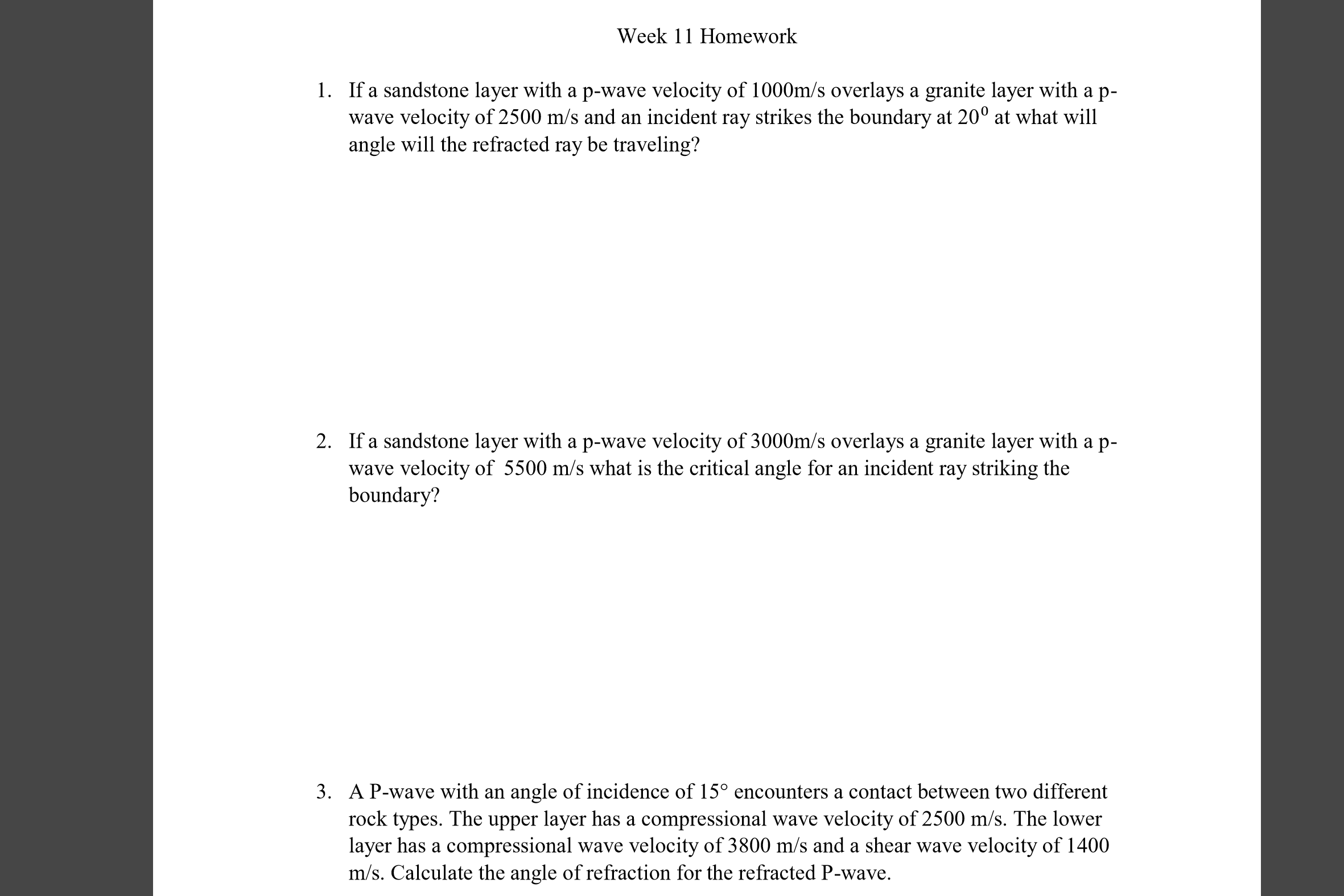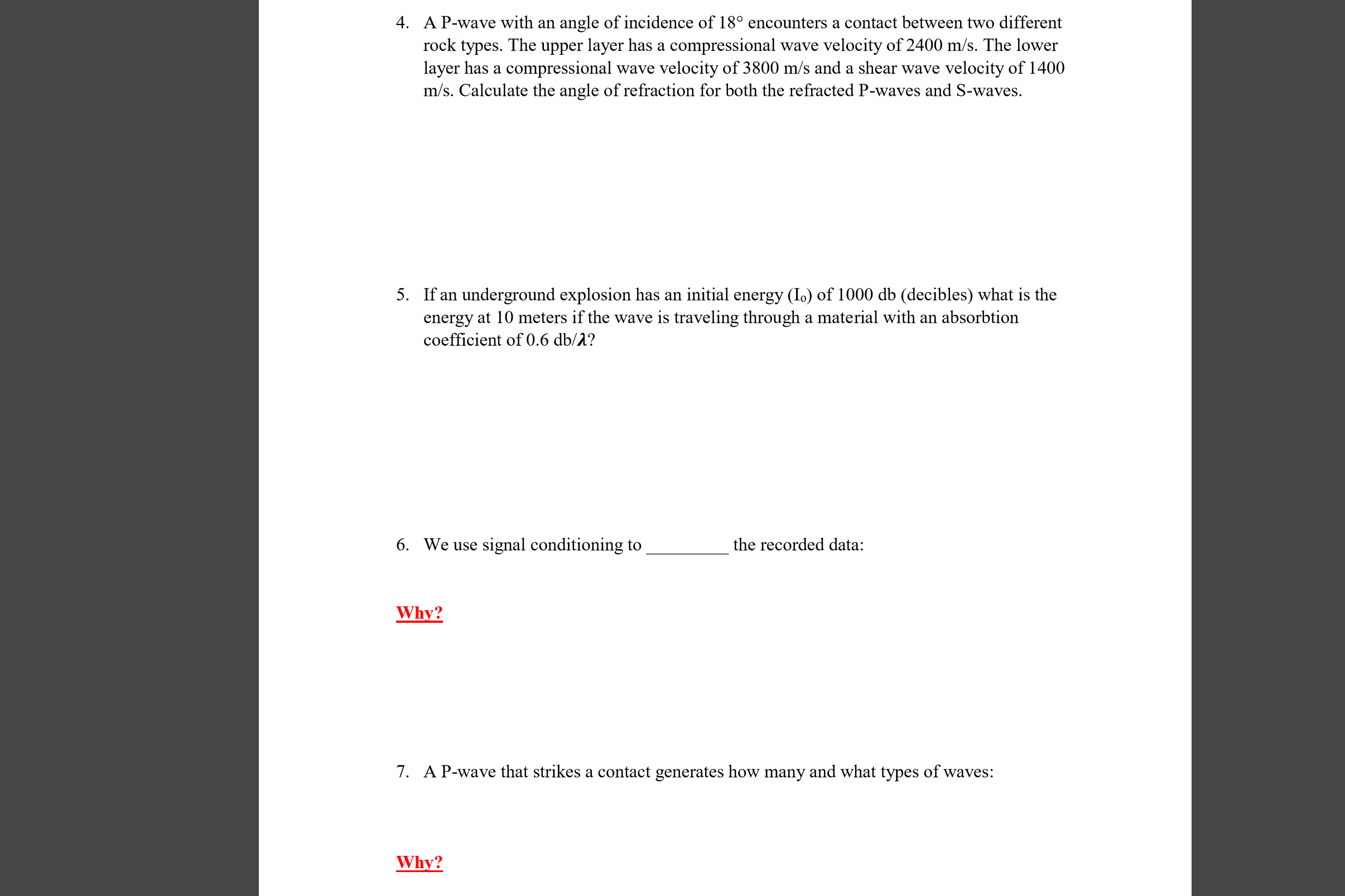I need help with this geophysics homework with all solutions
Week 11 Homework 1. If a sandstone layer with a p-wave velocity of 1000m/s overlays a granite layer with a p- wave velocity of 2500 m/s and an incident ray strikes the boundary at 200 at what will angle will the refracted ray be traveling? 2. If a sandstone layer with a p-wave velocity of 3000m/s overlays a granite layer with a p Wave velocity of 5500 m/s what is the critical angle for an incident ray striking the boundary? 3. A P-wave with an angle of incidence of 15 encounters a contact between two different rock types. The upper layer has a compressional wave velocity of 2500 m/s. The lower layer has a compressional wave velocity of 3800 m/s and a shear wave velocity of 1400 m/s. Calculate the angle of refraction for the refracted P-wave. 8. You have been hired to do a seismic survey of the national monument, Devil's Tower. What energy sources should you NOT consider using? 4. A Pwave with an angle of incidence of 18 encounters a contact between two different rock types. The upper layer has a compressional wave velocity of 2400 m/s. The lower layer has a compressional wave velocity of 3800 m/s and a shear wave velocity of 1400 m/s. Calculate the angle of refraction for both the refracted P-waves and S-waves. 5. If an underground explosion has an initial energy (10) of 1000 db (decibles) what is the energy at 10 meters if the wave is traveling through a material with an absorbtion coefcient of 0.6 db/A? 6. We use signal conditioning to the recorded data: E 7. A P-wave that strikes a contact generates how many and what types of waves: APPLIED GEOPHYSICS Week 11: Seismicity SEISMIC WAVES AND WAVE PROPAGATION How does seismology work? A sudden disturbance occurs at a small, localized region The displacement propagates outward as a wave front Induces motion in the materials at the arrival point Example: Throwing a pebble into a lake WAVE TERMINOLOGY Wavelength (): The distance between two adjacent points on the wave that have the same phase or similar displacements. Generally crest to crest or trough to trough Amplitude (A): Maximum displacement associated with the particle motions that occur as the wave passes through the material Period (T): The time it takes for two successive wave crests to pass a reference point NOTE: t = time, but T = period Frequency (f): Number of repetitions per unit time Wavelength Period Frequency (f): Number of repetitions per unit time, in the case to the right, there would be 13 repetition per this unit of time Amplitude REVIEW - SOME TERMS AND BASIC EQUATIONS Frequency: repetitions per second 1 = Unit: Hertz (Hz) Velocity: time it takes a wave front to traverse a known distance = Unit: meters per second (m/s) If we know wavelength and frequency: = ELASTIC COEFFICIENTS Stress = force acting on an object Strain = the resulting deformation When a stress is applied to an object, the resulting strain is immediate If the object returns to it's original shape it is said to have elastic behavior ELASTIC COEFFICIENTS The relationship between stress and strain is: = = applied stress (N/m2) E = Young's modulus (N/m2) = resulting strain (dimensionless) Elongation () is an example of strain = = Elongations can be measured for each direction Poisson's Ratio () (dimensionless) = 1 3 0.5 (ALWAYS) BULK MODULUS (K) If you subject an isotropic (uniform in all directions) material to a general pressure change, the volume will change The Bulk modulus (K) is the change in volume divided by the original volume, compared to the pressure change = where = (N/m2) RIGIDITY MODULUS (G) Deformation of a solid is possible by a simple shear Ratio of shear stress ( ) to shear strain () = (N/m2) SEISMIC WAVES Four types of seismic waves Two types of body waves P waves S waves Two types of surface waves Rayleigh waves Love waves SEISMIC WAVES Two types of body waves P-waves (Primary waves) = Longitudinal (particle movement back and forth along the direction of the propagation) Also referred to as compressional waves S-waves (Secondary or Shear waves) = Transverse (particle motions are perpendicular to the ray) Two components Parallel to ground surface (SH) Vertical (SV) Both components must be perpendicular to the ray P-Wave P-wave S-wave SEISMIC WAVES Two types of surface waves Rayleigh waves = propagate by particle movement confined to a vertical lane, is retrograde elliptical, and is in the direction of wave travel Also known as ground roll (these are like water waves) Love waves = Travel by a transverse motion of particles parallel to ground surface Similar to S-Waves, but confined to the surface Rayleigh Waves Rayleigh Waves Love Waves SEISMIC WAVE VELOCITIES Equations you need to know: = = = + 43 = 1 1 2 = (1 ) (12)(1+) 1 2(1+ ) UNITS Watch your units! Everything must be reported in SI units Kg, m, s Density (for example) is usually given in g/cm3, so how 10 do we convert 3 into SI units? 10 3 1 1000 (100 )3 (1 )3 = 10,000 /3 SEISMIC WAVE VELOCITIES G is zero for liquids, shear waves cannot be propagated by liquids... remember = We focus mainly on P-wave (compressional) velocities in seismic exploration When planning a survey, we can use approximate values Engineering toolbox is an excellent resource http://www.engineeringtoolbox.com/ A FEW GENERAL RULES Unsaturated sediments have lower wave velocities than saturated sediments Unconsolidated sediments have lower wave velocities than consolidated sediments Velocities are similar in saturated, unconsolidated sediments Weathered rocks have lower wave velocities than similar rocks that are unweathered Fractured rocks have lower wave velocities than similar rocks that are unfractured RAY PATHS IN LAYERED MATERIALS Reflection and Refraction occur at every boundary between materials Reflection is the part that \"bounces off\" Refraction is the part that continues through the new material Huygen's Principle All points on a wave front can be considered as point sources for the generation of spherical secondary wavelets Used to generate the arrival of a wave at a given time Given the position of a wave front at Time t1 and applying Huygen's principle, the position of the wave front at time t2 is determined FERMAT'S PRINCIPLE Principle of least time In the propagation of waves, the wave path between any two fixed points is the one along which the travel time is the least of all possible paths REFLECTION A wave front is reflected when it hits a surface of two materials that have different physical properties Such as how fast the energy can travel through them, which we call the velocity of the material (V1 and V2) The angle between an incoming ray and a line perpendicular to the surface is called the angle of incidence (1) WHAT PATH WILL THE REFLECTED WAVE TAKE? What is the relationship between 1 and 2? We can use both Fermat's and Huygen's principles to determine the path Huygen's Principle: all points on a wave front can be considered as point sources for the generation of spherical secondary wavelets Fermat's Principle: Principle of least time First we need to determine which path is the shortest Then we can use trigonometry Fermat's Principle: Which path takes the least time? REFRACTION Almost identical to the process we use to determine the angle of incidence We can use both Huygen's Principle and Fermat's principle SNELL'S LAW = Fundamental in deriving other expressions to utilize the reflection and refraction of seismic waves in deducing subsurface relationships. Can be used for both S and P waves, but be mindful of the appropriate velocities! SNELL'S LAW i = 10 Example: A ray traveling through saturated sand (velocity of 1000) reaches an interface with granite bedrock (velocity of 5000) at an incident angle of 10. What angle will the refracted angle ( ) be? = V1 = 1000 m/s V2 = 5000 m/s SNELL'S LAW = = , so = sin (10) = 0.17 = 1000 m/s = 5000 m/s = = ( ) . = . Each incident P-wave results in both a reflected P-wave AND a reflected S-wave Notice that a reflected S wave has a smaller angle of reflection Notice that a refracted S wave has a smaller angle of refraction Notice that a refracted S wave has a lower velocity than the refracted P wave Remembering these relationships is important. Why is this the case? CRITICAL REFRACTION Critical Refraction is when the refracted ray is at exactly 90, and thus it travels right along the interface If the angle of refraction is above 90, the ray is totally reflected An incident ray has to be at a specific angle to cause critical refraction, the angle is based on the velocities of the 2 layers involved. = sin1 1 2 CRITICAL REFRACTION We can visualize this wave as travelling parallel to the surface and creating disturbances Creates secondary waves also at the critical angle (parallel to the reflected wave from the incident wave) Called a head wave Head Wave Generation: sin = 1 2 DIFFRACTION If a disturbance is generated at the surface and encounters a sudden change of curvature at a velocity discontinuity, additional waves are generated that cannot be predicted by reflection or refraction methods Illustrated well when using Huygen's Principle Why? WAVE ARRIVALS AT THE SURFACE Wave energy diminished as the wave travels through a material, and is reflected and/or refracted Compressional waves have the greatest velocities Always arrive first at a destination Shear wave arrivals are difficult to detect at a short distance So we almost always concentrate on P-waves WAVE ARRIVALS AT THE SURFACE Assume that geophones are placed at even intervals from a shot point If we can calculate the path distances for each wave and the velocities over that path, we can determine the time of arrival at each surface geophone SECTION 2.3 - WAVE ATTENUATION AND AMPLITUDE The major goal in seismic exploration is the interpretation of wave arrival patterns at the surface Not easy even in simplified problems with homogeneous materials What contributes to the confusion? SPHERICAL SPREADING Picture wave energy spreading outward from a disturbance as a spherical wave front For each meter the wave travels the energy must be distributed over a much larger area. Therefore, at any one point along the radius of spreading, the amount of energy must decrease. SPHERICAL SPREADING The surface area of a sphere is 4r2 r is the radius The energy distributed over the new area of the wave front must decrease as 1/r2 Wave amplitude decreases as 1/r (Because amplitude is proportional to the square root of wave energy) ABSORPTION Seismic waves propagate by distorting (straining) the materials they pass through I = I0e-qr I = energy intensity I0 = initial energy intensity e = Euler's number, a mathematical constant (~2.718) q = absorption coefficient in db/ (decibels/wavelength) r = distance Energy losses due to absorption are much greater at higher frequencies than at lower frequencies when measured at a given distance from the energy source ABSORPTION The Earth is often referred to as a low-pass filter Lower frequencies are transmitted with much less energy loss Low velocity waves will lose energy more quickly from absorption than high velocity waves S-waves will lose energy faster than Pwaves ENERGY PARTITIONING The total amount of energy must remain constant between the incident wave and the reflected and refracted waves Therefore, amplitudes of refracted and reflected waves will be diminished relative to the incident wave ENERGY PARTITIONING If P-wave incidence is normal (perpendicular) to the interface, you can reduce the equations to a simple form since no S-waves are generated under normal incidence. For Amplitude Reflection: = 2 2 1 1 2 2 + 1 1 For Amplitude Refraction: = 21 1 2 2 + 1 1 = density of the layer V = Velocity of the layer ENERGY PARTITIONING For Energy Intensity Reflection: = 2 2 1 1 2 2 2 + 1 1 For Energy Intensity Refraction: = 4 1 1 2 2 2 2 + 1 1 2 Remember that this can only be used for simple cases OBSERVATIONS 1. At low angles of incidence, most of the energy is in the refracted P-wave 2. At high angles of incidence, most of the energy is in the reflected P-wave 3. Both the refracted P-wave and the refracted s-wave 'disappear' at the respective critical angle 4. The energy in the \"partitioned\" S-wave is relatively low compared to the Pwaves and are therefore hard to detect ENERGY SOURCES We examine the shallow subsurface, so we must choose an appropriate energy source How do we choose? Sufficient energy to provide reflections and refractions from the contacts Amplitudes large enough to be detected and displayed well enough How appropriate the choice is to the environment we are doing the study in SOURCE TYPES Most sources fit into three categories Weight drops (sledgehammer, a truck mounted crane releasing a weight, etc.) Explosives (Dynamite, seisguns) Vibratory (Vibroseis, air guns) Weight drops and explosives most commonly used in shallow work SOURCE CONSIDERATIONS Cost is always an important factor A source with high initial cost but low event cost may be preferable to one with a low initial cost but high repeat cost Convenience and efficiency Do you have to drill holes? Have 13 people operate it? Characteristics of site Rock type, local disturbances, etc Safety and environmental concerns SEISMIC EQUIPMENT Three main types Signal Detection Signal Conditioning Signal Recording SIGNAL DETECTION Geophones or seismometers Geophones are useful for lowerbudget surveys Small Rugged TYPICAL GEOPHONE ASSEMBLAGE SIGNAL CONDITIONING Damping Every geophone has a natural frequency where it will oscillate after a wave passes If the geophone continues to oscillate too much you can not detect the next wave Damping can reduce this problem, but over damping causes reduced sensitivity SIGNAL CONDITIONING Amplification and filtering Amplifier receives and amplifies the small signal generated by the geophone Filter reduces background noise so proper frequencies are recorded SIGNAL RECORDING The low frequency, high amplitude, signals can overload the sensors, making the high frequency signals undetectable Higher frequency geophones help reduce this issue Filters help reduce this issue SIGNAL RECORDING Most equipment today has digital recording capability Occurs after filtering and amplifying Benefits are enormous Digital oscilloscope display Sampling rate Enough to detect waves accurately Limited by Technology Cost constraints









